A special Teenage Edition of the Magazine this weekend features articles written by aspiring young journalists on issues that matter to them, from the impact of TikTok on their lives, to accessibility, sustainable fashion, making music, and keeping young women playing sport.
There is nothing more bizarre and surreal than scrolling through an average TikTok feed. No video is complete without several smaller videos playing at the same time, a veritable hydra of Subway Surfers, Minecraft Parkour and Family Guy. You blink in shock as four videos play in front of you, when you had expected only one. You’re half-listening to both Seth MacFarland and an AI-generated voice speak about the current economic state of the EU.
TikTok is a Chinese social media platform where users share short videos about anything under the sun. The app was launched in 2017. Its parent company, Bytedance, subsequently purchased the lip-syncing app Musical.ly and in 2018 merged it with TikTok. It now has more than a billion users and its short-clip format has been imitated by both YouTube and Instagram.
“Young people are overwhelmingly on TikTok,” says Caoimhe O’Brien, a digital expert with the youth mental health charity, Jigsaw. “A platform like TikTok gives us the ability to hand the mic to them and say, ‘Talk to us. Tell us how it is for you.’ Young people may not talk to you on Instagram but by God they’ll talk to you on TikTok.”
There are some significant downsides. “What’s popular is not the same as what’s true,” says Dr Colman Noctor, a child and adolescent psychotherapist. “Something will gain traction [online] due to the amount of times it has been viewed, not from the certainty of its information or content. So we follow what is popular rather than what is right… Moderate isn’t sexy. The middle-ground voice isn’t the one you’re going to hear because it’s bland and it’s measured and it’s balanced. The middle doesn’t sell.”
He worries about young people’s ability to regulate their input. “The algorithm is not interested in saying, ‘[He] looked at 15 sad things here, I might throw in a lip-sync joke here to pull him out of it.’ It’ll just keep giving you what you want rather than what you need... The whole infrastructure of the device is against regulation. It’s [like] trying to go on a diet in the sweets aisle in Aldi.”
O’Brien is still optimistic about the technology’s potential to connect people, but agrees with Noctor that social media platforms tend not to intervene when people’s usage is problematic. This means that, as things stand, young people and their families have to learn to control their own time on these platforms.
“There are definitely things you can do to make your online space more positive,” she says. “Ask yourself do you feel better or do you feel worse after having been on your phone. It might be an idea to curate your feed. Examine who you’re letting in and for how long. The app has functionality to both time your usage and to block people from your ‘for you’ page... It’s [also] important to have an open dialogue about the content you’re encountering, an open door to a parent or to a guardian.”
But what do young people themselves think? We spoke to six young people about their experiences of TikTok and other social media platforms.
Bel Nabulele is 16 years old, lives in Dublin and is a volunteer with the youth information and support platform Spunout.ie.
Izzie Solan is 17 years old, lives in Dublin and is a volunteer with Spunout.ie
Amina Abd Allgany is 20 years old, lives in Navan and is a volunteer with the youth mental health charity Jigsaw.
Raewyn Downey is 19 years old, lives in Tipperary and is a volunteer with Jigsaw.
Zach Garvey is 17 years old, lives in Tralee and has started creating his own content.
Jamie Feery Canning is 17 years old, lives in Dublin and worked with the It’s Our Social Media campaign run by the LGBTI+ youth organisation BelongTo.
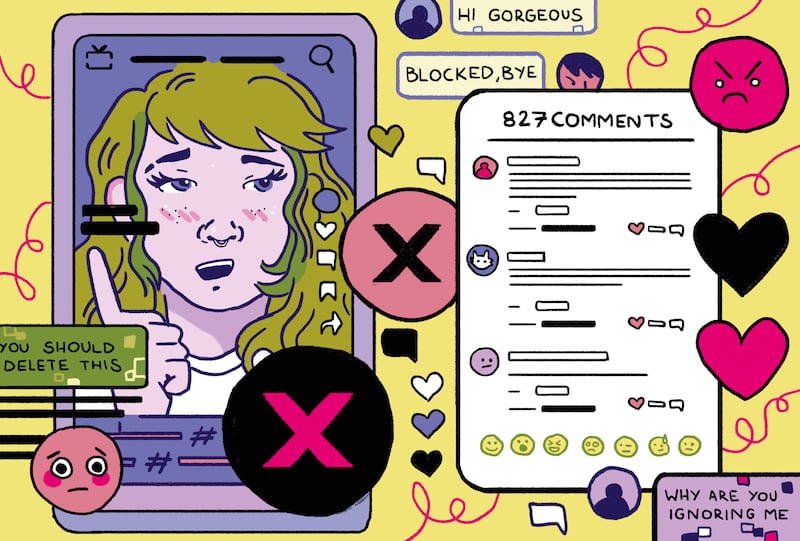
What’s the most ridiculous TikTok trend you have encountered?
Amina: The one where they stuck garlic up their noses. Apparently it would clear up your sinuses.
Izzie: When they used to use shot glasses to make their lips bigger. In 2019, Kylie Jenner said, “I’ve never had lip injections, it’s just make-up.” So it became a big trend for people to use shot glasses and make “duck lips”. The pressure from the shot glasses would make them bigger, but would lead to horrible bruising as well. She influenced a lot of young girls.
Raewyn: During Covid when everyone was drinking egg yolks. One person started doing it and then everyone started doing it.
Did the Covid lockdowns influence how you use social media?
Zach: Yeah, I definitely think that’s what made TikTok. Everyone was at home, no one had anything better to do.
Amina: I was in transition year during lockdown, so I didn’t have any assignments to do or homework or anything, so all I literally did was just go on to TikTok. It definitely influenced how much I go on it now.
What age were you when you started using social media?
Jamie: My first social media was Instagram and I got it when I was 11. I was young but I wasn’t too young. My parents, thankfully, educated me on it, making me aware of the dangers of social media and what I should and shouldn’t do.
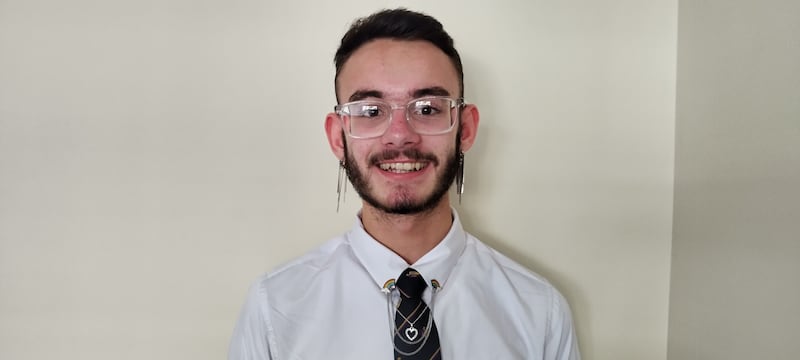
Amina: I was eight when I first got social media.
Zach: I was 11.
Raewyn: I was eight or nine. I got Snapchat first because I saw other people had it, so I wanted it.
Bell: I got Instagram when I was seven years old. I really didn’t understand the dangers of it.
Izzie: I got social media at 12, during the summer of sixth class. I’d always advocate for that time period because you get to keep in touch with your primary schoolfriends but you’re not introduced too young because I think that’s the thing now. Kids who are young in primary school are on it and then are growing up considerably faster. And schools can’t adequately teach about it because they have to implement courses, but because of the nature of social media it’s always evolving. What’s cool this week will be old news in two weeks.
How would you describe your typical social media use in a day? What different platforms do you use?
Jamie: I have a routine for how I’d use my apps. It’s really weird. It’s just something I’ve developed. I go to Snapchat first, have a look, see if I’ve any unopened snaps or chats, then I’ll watch people’s stories and then I’ll close Snapchat. Next, I open Instagram, have a quick look through the feed, stories, messages, then close it. Then I go to Facebook, because I’m a 40-year-old mammy at heart [laughs]. That’s more for family, that and memes, believe it or not. Facebook actually does have quality memes. Then TikTok, TikTok’s the outlier. It’s not in my pattern. TikTok is its own thing. I use it at random points of my day.
[ TikTok spied on me. Why?Opens in new window ]
Izzie: So, Snapchat is easy one-to-one communication or in a group setting, it’s just for texting and sending video or photos. Instagram is where you create the idealised life, the photos, the aesthetic snapshots… TikTok, Instagram and YouTube is the little trifecta of social media that can really influence people and create ideologies, ideas of how to live and to do certain things.
Which one would you use the most?
Izzie: TikTok.
Amina: I’m on TikTok all the time, I go on to [my phone] in the morning and literally just sit in bed with my cup of tea on TikTok. It’s such a bad habit.
Bel: I’m not on TikTok as much as every other teenager. I’d mostly just use Instagram and obviously YouTube, because everything’s on YouTube.
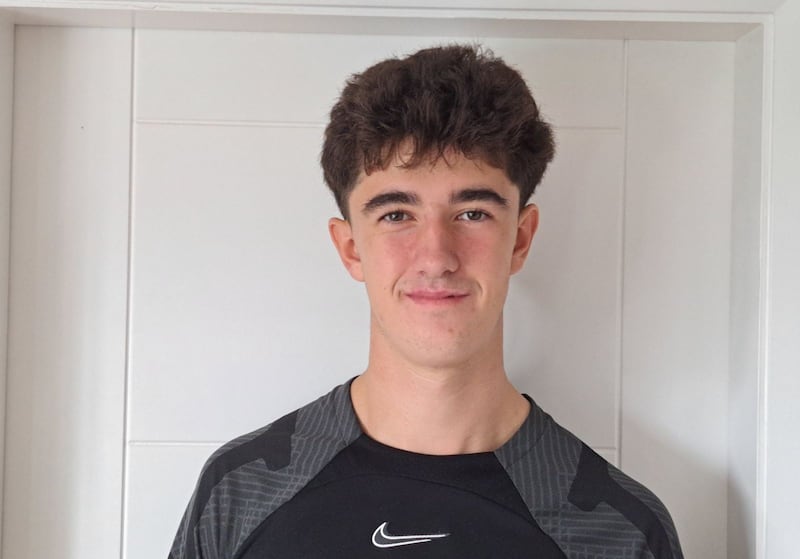
Zach: I was on TikTok way too much in the summer of 2021. It was at least five hours a day. It was mad, but I went from using it five hours a day to not at all for a year.
I use Instagram instead and prefer it. You can personalise it much more and control it to see only what you want to see.
TikTok’s algorithm is very random. It’s way harder to control… The [videos are] all 10 seconds so you think to yourself… this video was bad but it’s fine it was only 10 seconds of my life… This won’t waste three hours of my life, watching this, but actually it will.
Do you think the randomness is part of the reason why it’s so compelling?
Amina: Yeah, exactly. You just never know what’s gonna come up, so it’s exciting.
Izzie: You’ll get a couple of really good videos in a row, then you’ll just keep scrolling, trying to find more really good videos further along the line.
Do you get useful stuff from TikTok and social media?
Zach [laughing]: Usually the good stuff is telling me to get off TikTok.
Amina: Some things that I’d look up [on TikTok] would be “how to reduce anxiety” or “going to work with anxiety”. It’s actually really helpful, they do give you tips. So I’d find that sort of content really useful.

Raewyn: I literally live in the middle of nowhere… It’s grand for me now, I can drive myself, but until a year ago it would be all through social media if I wanted to be with my friends. Okay my mam will drop me there... So it might be different for people whether you’re in a town or a city but I know that my other friends in a rural setting say it’s the same.
Bel: I can see the good part of social media and the bad part of social media. It was very useful for me… I kind of did need it in a way. I didn’t speak any English, my parents didn’t speak any English [Bel’s family are from Nigeria] so it was kind of how I learned about different opportunities, how I learned about initiatives and different things that I could do.
Izzie: Also, you can find content that you can relate to on TikTok. Sometimes it’s a relief because you’re like... I feel like this but someone else does too. So there’s that sense of community, which, depending on the issue, can be good or bad.
Do you think short-form content affects your attention spans?
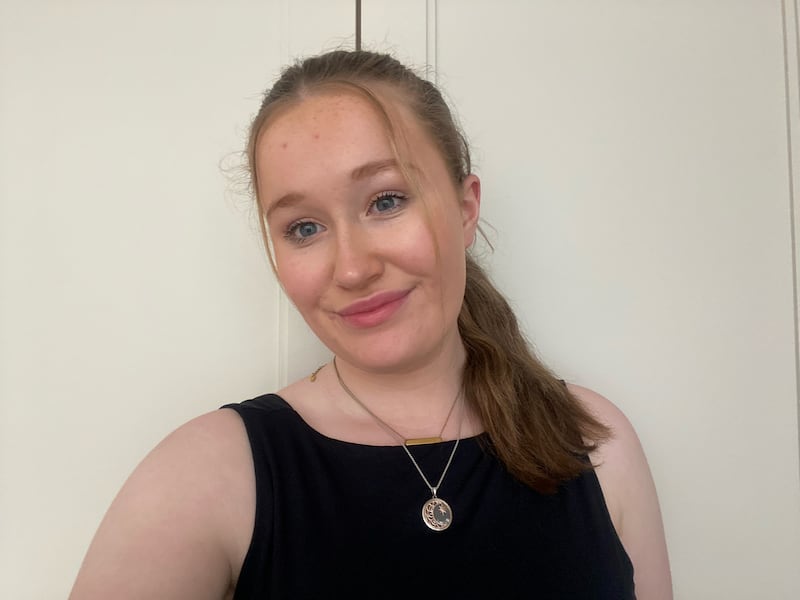
Izzie: I think a lot of media now is quite short. Remember when [the Martin Scorsese film the Irishman] came out a couple of years ago? It was four hours and people were like “I’m not sitting through this.”
Amina: I don’t think I could actually watch a movie any more because you’d have to sit there and watch the introduction, and only when you’re 20 minutes into the movie do you actually realise whether you like it or not.
Zach: Watching movies was no problem before Instagram and TikTok. It’s got a lot harder. I was watching Oppenheimer with my friends and it’s a three-hour movie, but I look around and I see some of my friends on TikTok.
Jamie: Yeah, I find that at certain parts I just get bored with what’s going on while watching a movie and go on to TikTok instead.
Raewyn: [I sometimes watch] random EastEnders episodes [on TikTok] even though I don’t watch it, just because it’s there… I do watch Netflix and stuff as well. It’s not like I’m just too lazy to go and watch TV!
Why watch it on TikTok though?
Raewyn [laughing]: It’s pure short, and there’s a cliffhanger so I want to see the next one... I’ll start off at part one and by the time I’m off my phone I’m at part 35 and I’m like oh my God.
Izzie: Sometimes there are also videos accompanying videos, so on one half of your screen you’re going to have Family Guy, Big Bang Theory, Young Sheldon and on the other side [there’s] “five-minute crafts”, weird cooking videos… You can flick between the two without even leaving the video.

Too much Tubridy: What Irish teenagers think of the news
This weekend, for the first time, the content of The Irish Times Magazine will be written entirely by teenagers. The six volunteers tackle subjects including the pitfalls of Tiktok, why many young women drop out of sport and what it is like to be a wheelchair user. One of their mentors for the project was Patrick Freyne, who recorded a conversation with them about the way their generation consumes news and the issues they really care about.
How do you feel about the time you spend there?
Zach: You look at your screen time and say what could I have done with all those hours, instead of just scrolling?
Jamie: It depends on what you see that day because again everyone’s “for you” page is usually unique to them and it can vary so much within a few minutes... It’s so, so easy to get distracted, and because of how addictive it is, the time goes by so quickly and then suddenly an hour or more has been wasted scrolling through essentially meaningless videos.
Bel: It’s such a normalised thing. Everyone’s addicted to social media. Everyone’s addicted to TikTok… It’s like a joke at this point. Like you’re not really seeing the dangerous part of it. You’re just [thinking] oh, all my friends are doing it.
Zach, you have started creating video content. Were you inspired to do it by what you saw online?
Zach: Yeah, I was inspired. I just really like seeing perfection. I’d see an edit and go wow. That is incredible. How long did that take them? And how can I do that myself? I really like creating things.
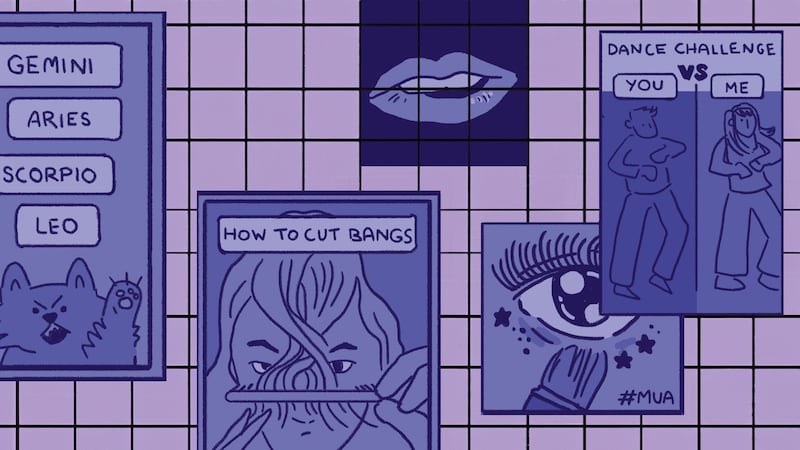
Jamie, you said your sister makes TikTok content too
Jamie [laughing]: Well, by content, I mean doing all the trendy dances. So she’s not an influencer or anything. If they enjoy it, I’m all for it. Sometimes though there’s a pressure on people, especially young girls, because they’re seeing all of these influencers giving off the impression that they’re perfect… So much of what we see on social media, especially TikTok, is so heavily edited.
Raewyn: When I was making content, I would sometimes go why am I not getting comments complimenting me like all these other people are getting? If you don’t get the comments or you don’t get the likes that you see all these other people getting, that can lead you then to compare yourself.
Does how people experience TikTok affect their mental health?
Raewyn: I definitely think that it’s linked to mental health… If a TikTok comes up and it’s very depressing or the music’s really depressing, I find sometimes I’ll come away and my mood would actually go down.
Jamie: When it comes down to activism and you’re talking about homophobia and transphobia, and if that’s coming up on your feed or even if it’s just being reported on, you’re conscious of it, you’re aware of it. Like, nobody ever forgets that these things exist, you can’t in this world, but when it’s constantly in your face, it’s a reminder that this is the world that we live in.
Amina: When I was younger I was struggling with how I looked and I used to go on to TikTok and see all these “What I eat in a day” and diet plans [and] even just watching them made me feel so much worse about myself.
Raewyn: [At Jigsaw we] have meetings once a month and our main aim was to show that there are real people out there, that it’s not all fake. We looked a lot as well at how to target boys… because obviously boys are going to struggle with their self-image as well. It’s not just girls.
Zach, you mentioned some very polarising, gendered content that affected you when you were younger?
Zach: In 2021. It was [called] something like “the Boys vs the Women”. It was so stupid. You had one side of extremists saying, “Oh yeah, I hate women, women are terrible.” And the other side [saying] “kill all men”. It was like, “Are you a man or are you a woman? Right, you’re on our side.” And I found myself getting influenced by it, and you start to side against the women… And then I thought to myself, that’s not me. This isn’t who I am. I don’t hate women!
Izzie: Everything becomes much more extreme [on social media], like those trends, “men versus women”. It’s created a very polarising space.
Jamie: Another form of negative content on TikTok was Andrew Tate [and] all of the crap that he spews... Seeing someone like that for people who would be interested in MMA, especially young boys, that’s extremely dangerous because it’s so toxic… The stuff he was putting out there on the internet, his views about women. Literally anything he said was the epitome of toxic masculinity.
Can TikTok and social media be a positive space for activism?
Bel: As an activist [concerned with gender equality and migrant rights] I do find it very helpful to get good messages out there and spread awareness, but there is a double-sided coin to that. It’s also a way to get bad messages out there. On social media, it just depends on whose voice is louder.

Jamie: I did a campaign with BelongTo and it was called “It’s our Social Media”, and that was to take back the power from the hate we receive as queer individuals and turn it around, reinforcing that we’ve just as much of a right to be on social media as anybody else.
Have you seen an increase in homophobic or transphobic content?
Jamie: It’s complicated. I don’t know if I could say there’s been an increase because it’s always been there, but with social media it’s more highlighted now… or at least it seems more prevalent.
Do you ever get unwanted interactions from people?
Bel: I did this RTÉ thing focused on the [new sex education programme for schools] and people searched up my name on Instagram and started messaging me saying how they didn’t like [my] stuff. I was only 16 and like, how did you find me?
Were you being abusively trolled?
Bel: Yeah, I was. Obviously there’s freedom of speech and a right to an opinion and everything but I didn’t ask for their opinion.
Izzie: That kind of stuff just happens and you can’t police it... And you also get messages from fake accounts going, “Hi ... I’ll give you a grand a year, send pics.”
Amina [nodding in recognition]: Old men on Instagram texting you… I just usually block them all obviously. But it’s scary how many people there actually are who do that.
That’s shocking. Do lads get these too?
Zach: No, there’s not really an equivalent for men, just the occasional scam.
When bad stuff happens online, would you tell anyone about it, a parent or a teacher?
Bel: My parents would usually be the people I’d go to first. Especially when I was young, because I didn’t really understand social media and they knew, “You have to report this person”; “You can block him too;” and “These features could protect you a little bit”.
Jamie: Talking about it is the most important thing anyone could do. And obviously it’s a lot easier said than done, because not everyone has the support structures that they should have, especially at home, but it could be anybody like a trusted friend, teacher, whoever.
Do you have any strategies for spending less time on social media?
Izzie: I’ve Screen Time [a monitoring app] set up on my phone. As in, I have x amount of time in a day that I’m allowed to use it... I don’t always follow it, but I try. And it keeps me accountable.
Bel: Like Izzie, I also try to use Screen Time, but for me it kind of never works out. I always end up extending it and giving myself more time.
Amina: If I do feel like I’m going on it too much, I will turn it off and just watch YouTube or Netflix or something. I’m not heavily addicted to it, I would say. I do enjoy it.
Give us an example of your favourite creators or content
Jamie: I follow a non-binary influencer on Instagram… Matt XIV… Their actual name is Matt Bernstein. The way they report on some of the very concerning stuff like homophobic attacks, it’s done very well, in a straight-to-the-point sort of way.
Izzie: Leo Skepi... It’s very much like “day in my life” kind of content, but he also does a podcast and it’s advice and stuff. His whole thing is “Sometimes you have to put yourself first” and I’d feel better after watching his content.
Zach: I love gym and training content, content that got me into going to the gym. Self-improvement is important to me.
Amina: I follow this girl called Spencer Barbosa and she posts a lot about things like body positivity and confidence and I really like watching her videos.
Bel: There’s this influencer, her name’s Sarah Kate [Smigiel]. She’s a non-binary influencer who embraces the femininity aspect and they’re so authentic and real. It’s so cool.
Darragh Kelly and Ben Lynch were mentored by Irish Times journalist Patrick Freyne.
This article has been edited for clarity and length. If you are affected by any of the issues mentioned, Spunout (spunout.ie) has a text-based mental health service for young people at textaboutit.ie (text “HELLO” to 50808 to start a conversation). Jigsaw offers text based support with a clinician at jigsaw.ie/chatonline. The LGBT youth service BelongTo can be found at belongto.org. These organisations also have a lot of information about mental health and wellbeing on social media on their websites. To contact the Samaritans 24-hour service, call 116 123 or email jo@samaritans.ie.











